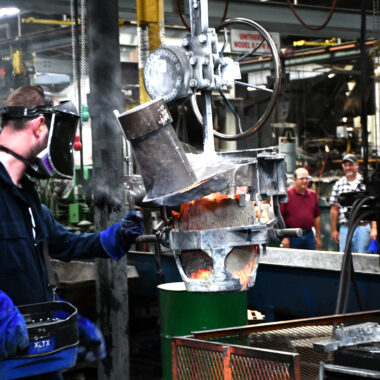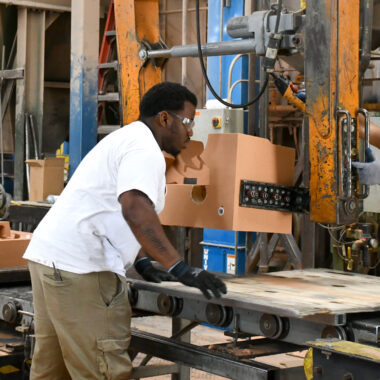Unraveling About Aluminum Casting: From Essentials to Experience
Unraveling About Aluminum Casting: From Essentials to Experience
Blog Article
Unlocking the Prospective of Aluminum Casting: Proven Approaches for Success
Light weight aluminum casting has actually long been identified for its convenience and widespread applications across various industries. Join us as we check out the vital elements that can drive light weight aluminum casting towards unrivaled success in today's affordable market landscape.
Advantages of Light Weight Aluminum Spreading
One of the primary advantages of light weight aluminum casting is its lightweight nature, which adds to fuel performance in industries such as auto and aerospace. Furthermore, light weight aluminum is highly malleable, permitting for intricate and intricate shapes to be easily generated through casting processes.
Furthermore, aluminum spreading gives exceptional corrosion resistance, making it ideal for applications where direct exposure to rough environments is a worry. The material additionally shows good thermal conductivity, which is helpful for markets calling for warm dissipation, such as electronics (about aluminum casting). Aluminum is fully recyclable, lining up with the growing emphasis on sustainable techniques in modern manufacturing.
Layout Factors To Consider for Casting
When considering casting style, thorough attention to information is paramount to guarantee the effective production of high-grade elements. The design stage plays a vital duty in the general success of an aluminum casting job. One crucial factor to consider is the selection of appropriate geometries and functions that promote the casting process. Developers need to think about elements such as draft angles, fillets, and wall thickness to make sure proper steel flow and solidification during spreading.
Additionally, factors to consider connected to parting lines, gating systems, and risers are vital to stop problems like porosity and shrinkage. It is important to enhance the layout for reliable product use and decrease post-processing needs. Simulations and prototyping can be useful devices in refining the spreading and evaluating layout prior to full-blown production.
Collaboration between layout engineers, makers, and foundries is important to attend to any type of possible obstacles early in the style phase. By incorporating these factors to consider right into the casting design procedure, producers can improve product top quality, minimize costs, and inevitably unlock the full possibility of aluminum spreading.
Enhancing Casting Performance
Designing with an emphasis on optimizing product circulation and decreasing problems is important when intending to enhance casting effectiveness in light weight aluminum casting tasks. To achieve this, using simulation software can assist in recognizing potential problems prior to the spreading process starts. By imitating the flow of molten light weight aluminum, developers can adjust gating and riser styles to make sure correct filling and solidification, inevitably reducing the incident of flaws such as porosity or shrinkage.
Furthermore, applying proper heat treatment processes can improve the total spreading efficiency. Heat treatment can assist boost the mechanical buildings of the light weight aluminum spreading, making certain that the last part meets the needed requirements. In addition, using automation and robotics in the spreading procedure can simplify manufacturing, lower manual work, and increase overall efficiency.
Furthermore, continuous monitoring and quality assurance during the casting procedure are crucial for identifying any kind of inconsistencies and making certain that the final products fulfill the wanted criteria. By carrying out these methods, makers can improve casting efficiency, improve product quality, and inevitably attain higher success in light weight aluminum casting projects.
Quality Assurance in Light Weight Aluminum Spreading

Effective high quality control methods play an essential function in making certain the accuracy and integrity of aluminum spreading procedures. Quality Full Article control steps in aluminum spreading incorporate a variety of activities aimed at upholding particular requirements and determining variances that can compromise the final product.
In addition to process control, top quality control in aluminum casting includes rigorous screening and evaluation treatments at numerous phases of manufacturing. By implementing robust high quality control methods, aluminum spreading centers can deliver products that satisfy consumer expectations for quality, integrity, and performance.
Taking Full Advantage Of Productivity
To accomplish optimum monetary performance, a comprehensive strategy for making the most of earnings within light weight aluminum casting procedures need to be carefully devised and carried out. One crucial aspect of taking full advantage of success in light weight aluminum casting is maximizing production performance.

In addition, diversifying item offerings and checking out new markets can aid expand revenue streams. Understanding consumer requirements and market trends can guide tactical choices to maximize arising possibilities. Purchasing r & d to introduce processes or items can also drive success through differentiation and client satisfaction.
Final Thought
In conclusion, light weight aluminum spreading offers numerous benefits in check these guys out regards to layout flexibility, toughness, and cost-effectiveness. By very carefully taking into consideration layout factors to consider, improving casting effectiveness, executing top quality control measures, and making best use of productivity, producers can open the full potential of light weight aluminum spreading. This reputable and flexible process try this web-site has confirmed to be a successful choice for a vast array of commercial applications.
Furthermore, aluminum is highly malleable, enabling for elaborate and complex forms to be conveniently created through casting procedures.Effective high quality control practices play a pivotal function in making sure the precision and dependability of aluminum casting processes.In enhancement to procedure control, high quality control in aluminum spreading involves extensive testing and examination treatments at different stages of manufacturing. By applying durable quality control methods, light weight aluminum spreading centers can deliver products that fulfill consumer assumptions for dependability, high quality, and efficiency.
By very carefully taking into consideration style considerations, boosting casting performance, executing high quality control steps, and making best use of productivity, makers can unlock the full possibility of light weight aluminum casting.
Report this page